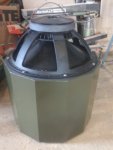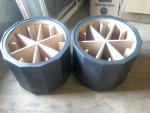The latest iteration of my small PA system will require 4 crossover points. Funds are limited, but I have 2 x DBX Driverack PA units which will do the job, however auto EQ becomes messy. I note that the Behringer DCX2496LE crossover can be used as a mono 6-way, and has an AES input for connection to the DEQ2496 EQ. My question is, can I drive two crossovers via AES from the EQ? I could then enjoy both auto EQ and auto time-delay settings on my 5-way system. Very appealing! I can find nothing in Behringer's extensive manuals that cover this scenario. Thanks in advance, Carl.
5-way stereo crossover - HELP.
- Thread starter Carl Klinkenborg
- Start date
You are using an out of date browser. It may not display this or other websites correctly.
You should upgrade or use an alternative browser.
You should upgrade or use an alternative browser.
Curious.
Each DriveRack PA is a 3-way crossover. Are you going to cascade them to get your 5-way system?
Are you planning on infra subs, and sizzle boxes ?
What are your crossover points ?
Yes, auto-EQ between 2 units may be... ah... interesting, if not impossible.
If you're doing live bands, I would want the vocals to be all on one passband.......
Chris.
Each DriveRack PA is a 3-way crossover. Are you going to cascade them to get your 5-way system?
Are you planning on infra subs, and sizzle boxes ?
What are your crossover points ?
Yes, auto-EQ between 2 units may be... ah... interesting, if not impossible.
If you're doing live bands, I would want the vocals to be all on one passband.......
Chris.
Hi Chris, I will run them in parallel using a Y-splitter. Pass bands are 25-60Hz and 60-120Hz on one unit; 120-650Hz, 650-7kHz, and 7kHz up on the other. I'm not sure what the Driverack does on auto EQ if the passband selected is not fullrange, and have not had the chance to test it yet. Recorded music only so
Sounds like a pretty interesting system you got going. Do you have some pics to post? Takes me long enough to dial in a 2 way crossover Im happy with.
Carl, I might suggest input to the first unit.
Low 25-60
Mid 60-120
High 120 +
Output of High goes to input of unit 2.
Low 120 - 650
Mid 650 - 7K
High 7K +
Ditch the y-cord.
I still have my doubts about auto-eq over 2 units.
last century I added a bunch of double 18's to an 8 box MT-4 rig installed in a club.
It was an interesting (and very long) day....
The clubbers were happy, the neighbors, not so much
Chris.
Low 25-60
Mid 60-120
High 120 +
Output of High goes to input of unit 2.
Low 120 - 650
Mid 650 - 7K
High 7K +
Ditch the y-cord.
I still have my doubts about auto-eq over 2 units.
last century I added a bunch of double 18's to an 8 box MT-4 rig installed in a club.
It was an interesting (and very long) day....
The clubbers were happy, the neighbors, not so much
Chris.
Thanks for the replies.
Ben - few pics as yet; system from low to high as follows: 2 x 21" ported, 4 x 18" sealed, 2 x dual 12" horn loaded/1.4" coaxial upper mid & HF (BMS) horn loaded. The mid-high cabs are the 'New DIY Mid High' by Peter Morris on this site, which I am very excited to be building. The 21s and 18s are of my own design, but pretty conventional apart from construction methods.
Chris - I love the idea of cascading the crossovers; so simple, but a genius step which I never would have considered. Many thanks.
The plans may have changed following a very professional reply from Behringer technical, which would allow me to use their EQ driving two of their crossovers via AES as mono 6-way units, removing one DAC/ADC step from the chain. I would also gain auto time-alignment in addition to auto EQ. I know many folks like to hate Behringer, but in over twenty years I have never had a failure, and the specs on paper of the components discussed here are better than dbx! Time, and listening, will tell...
Thanks again all.
18" sealed sub enclosures
 s:
s:
Ben - few pics as yet; system from low to high as follows: 2 x 21" ported, 4 x 18" sealed, 2 x dual 12" horn loaded/1.4" coaxial upper mid & HF (BMS) horn loaded. The mid-high cabs are the 'New DIY Mid High' by Peter Morris on this site, which I am very excited to be building. The 21s and 18s are of my own design, but pretty conventional apart from construction methods.
Chris - I love the idea of cascading the crossovers; so simple, but a genius step which I never would have considered. Many thanks.
The plans may have changed following a very professional reply from Behringer technical, which would allow me to use their EQ driving two of their crossovers via AES as mono 6-way units, removing one DAC/ADC step from the chain. I would also gain auto time-alignment in addition to auto EQ. I know many folks like to hate Behringer, but in over twenty years I have never had a failure, and the specs on paper of the components discussed here are better than dbx! Time, and listening, will tell...
Thanks again all.
18" sealed sub enclosures

 s:
s:Dang those things look crazy. Keep us updated on the results as the build progresses.
Carl, I suggest that you forget about using the auto eq feature. That's an inaccurate waste of time and is just creating unnecessary complexity for you..
Use a real measurement app
A good starting point would be REW, which is free.
https://www.roomeqwizard.com/
Use a real measurement app
A good starting point would be REW, which is free.
https://www.roomeqwizard.com/
Many thanks - REW is something I've been meaning to look into for a long time, however auto EQ is a handy quick fix for time-limited setups at gigs!Carl, I suggest that you forget about using the auto eq feature. That's an inaccurate waste of time and is just creating unnecessary complexity for you..
Use a real measurement app
A good starting point would be REW, which is free.
https://www.roomeqwizard.com/
If you're talking about making crossover/loudspeaker DSP type changes on a per-venue basis I suggest you looking at the wrong end of the fish.Many thanks - REW is something I've been meaning to look into for a long time, however auto EQ is a handy quick fix for time-limited setups at gigs!
You need loudspeaker processing to make the loudspeaker *system* work and play nice with its various pass bands, and that stuff DOES NOT CHANGE because you're in a 200 cap room or 2000 cap room. And because of the nature of the work being done, any kind of "auto EQ" is absolutely, positively the wrong tool for the job. Most of them are poor at doing broadband EQ and doing EQ on pass band basis is beyond the design intent of the feature. Add in that *most* of what you're doing in processing a loudspeaker system is working with TIME, and RTA or magnitude-only analysis cannot show you what is happening with the time relationships of various pass bands, only the magnitude result at whatever place the measurement mic is at.
Now to broadband EQ. For system voicing, Otto Eq is the wrong tool, as voicing is mostly a subjective tasked based on a desire aural presentation, not science or math (which are the basis of loudspeaker processing). Presuming the loudspeaker processing has been done well, voicing on a per-gig or per-venue basis can be done on the INPUT EQ of loudspeaker DSP, or as a separate device if external or analog EQ is desired. Using Otto Eq (Otto is my grandfather) for system "correction" *MIGHT* be useful, but remember that it's only valid for where the measurement mic is placed. It's probably more useful as a tool to verify what you think you hear in a certain spot (or 3 or 4) in a room than to be a trusted source of system EQ.
Finally, it's about this 5 way thing.... been there, did that... but with the technology of 30+ years ago. It was a great learning experience that got used a few times before being split into 2 systems. What I liked about the 5 way rig did not pay any extra money, but 2 systems did. Follow the money, and if your 5 way does that for you, rock on!
Use the crossover for BMS. removes one crossover point and makes boxes 2-way. Simpler and total cost $25.
Last edited:
lol' just spoke to Karl on the pm 6040 DIY thread it seems were doing the same kinda thing 5way here to however I already have the 2 Behringer LMS units so I'll have a few extra channels I am looking to go passive hf/vhf so that box can be powered by fully loaded nl4.
then the same for the bass-sub. just gonna need to get the power distro right.
then the same for the bass-sub. just gonna need to get the power distro right.
